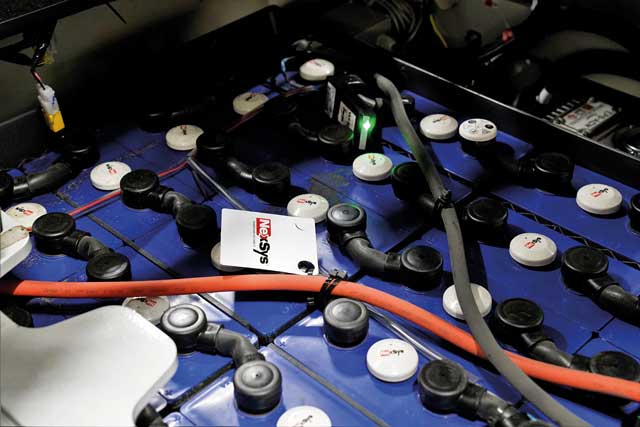
Maintenance is the key to maximising motive batteries’ power delivery, runtime and longevity. Yanis Lounnas, applications engineer at EnerSys, outlines ten ways to achieve this.
Lead-acid motive batteries dominate in electric industrial vehicles, such as forklift trucks. Most are flooded lead-acid units that need topping up with water, though some are valve-regulated lead-acid (VRLA) batteries which require no top-ups. These sealed packs include thin plate pure lead (TPPL) variants, which require even less maintenance. Here are ten pointers to get the best performance.
- Read the instructions
The battery’s instruction sheet will contain detailed information. Failure to follow procedures can invalidate the battery’s warranty. - Don’t overfill or underfill
In flooded batteries, lead plate electrodes are suspended in an electrolyte that must be regularly topped up with water. Plates can be damaged by exposure to air, reducing capacity and lifespan.
However, overfilling may cause acid leakage during the next charge as the electrolyte expands, which can result in overheating.
Use only deionised or distilled water and top up to the maximum level. Do this immediately after charging, or 20 minutes before charging ends. Don’t fill before charging unless the plates are exposed. - Check the electrolyte
Check electrolyte levels in flooded batteries after every ten charges. As a battery ages, it may require topping up more often. In conventional servicing, the specific gravity of each cell’s electrolyte is measured monthly. Strong variation between cells indicates a need for equalisation (see 8 below). - Watch charge levels
Avoid discharging a flooded battery to below 20% of its capacity: excessively deep discharge shortens its life. But recharging too long before the charge falls to 20% can also waste life. Conversely, TPPL batteries perform best when kept at a high state of charge.
Both sealed and flooded batteries should be recharged immediately after falling to 20% charge to discourage sulphation, a major cause of damage. Charge batteries fully before storage. - Watch the temperature
Extreme heat or cold will limit a battery’s performance and shorten its life. Refer to the product’s instructions for optimum ranges.
Some battery technologies have been adapted for cold environments such as refrigerated food stores. Ask your supplier to advise on the best battery and charger for these applications. - Keep it clean and tidy
Deal with acid spills from flooded batteries using an approved cleaning liquid. Spilt acid may create conductive circuits that drain charge. Wetness can have a similar effect, so keep the battery, its tray and its surroundings clean and dry.
Check all battery and charger plugs, connectors and cables regularly for corrosion and damage. - Control recharging times
Each recharge brings the end of the battery’s life closer. For most batteries, opportunity charging wastes potential life. If the battery is fast-charged, heat generation can reduce its life further. These options should only be used in emergencies. The exception is TPPL batteries, which can be fast-charged without damage, provided the battery is regularly brought back to its full charge. - Equalise, desulphate and refresh
Variation in voltage and capacity may develop between a battery’s cells. They can be rebalanced using an equalisation charge: a deliberate overcharge once every five to ten charge cycles. In flooded batteries, the same process can remove sulphate crystals from plates.
Some chargers offer a desulphation charge function. There are also special machines that deliver high-frequency electronic pulses to remove sulphate crystals. Batteries in storage need a regular refreshing charge to maintain their condition. - Choose the right charger
Batteries and chargers must be fully compatible. Use combinations recommended by the manufacturer and supplier.
High-frequency chargers are most efficient and “kindest” to the battery, with current supply tuned to its needs. To gain full benefit from advanced TPPL batteries your charger, like the NexSys battery charger series designed by EnerSys, should have a fast-charge facility. - Automate battery management
Automated aids for battery management and protection include the Wi-iQ battery monitoring device from EnerSys. This reports on temperature, voltage balance and electrolyte level. It also gives warnings and provides a history log for analysis. In larger fleets, the Xinx battery operations management system, also from EnerSys, provides for optimised battery healthcare and efficient use.
Further information: www.enersys.com

